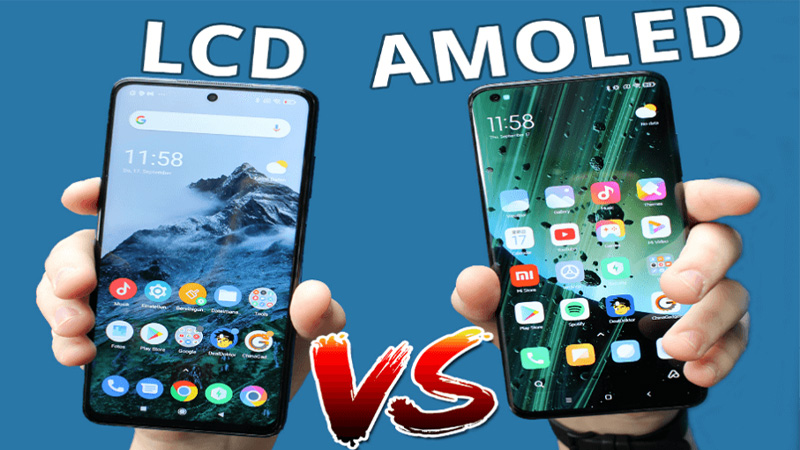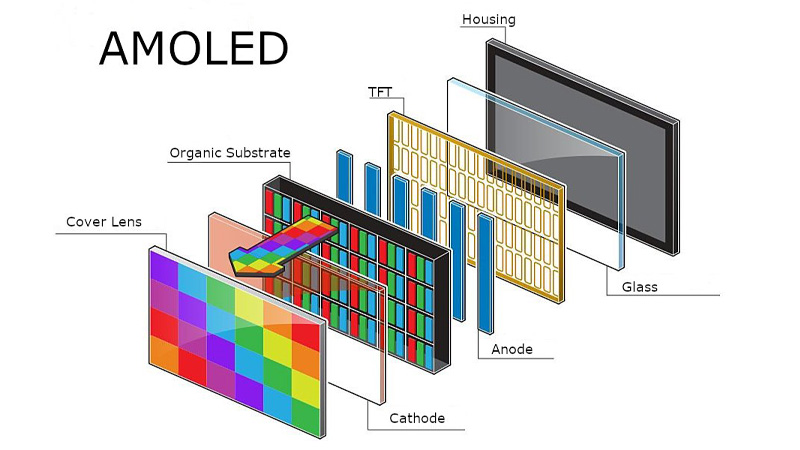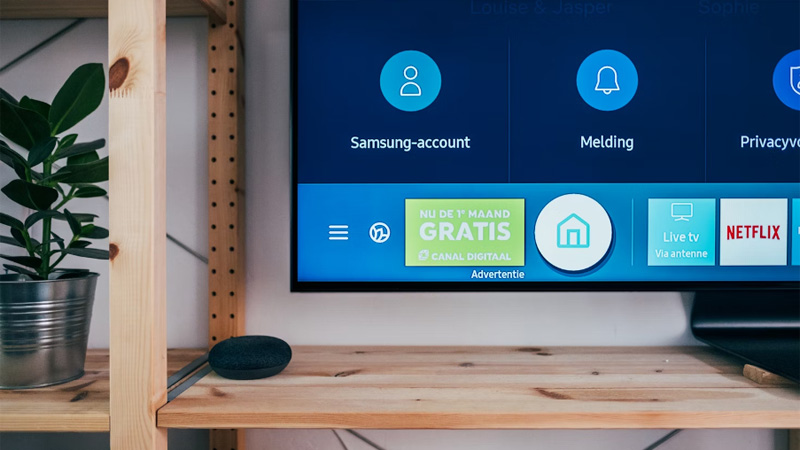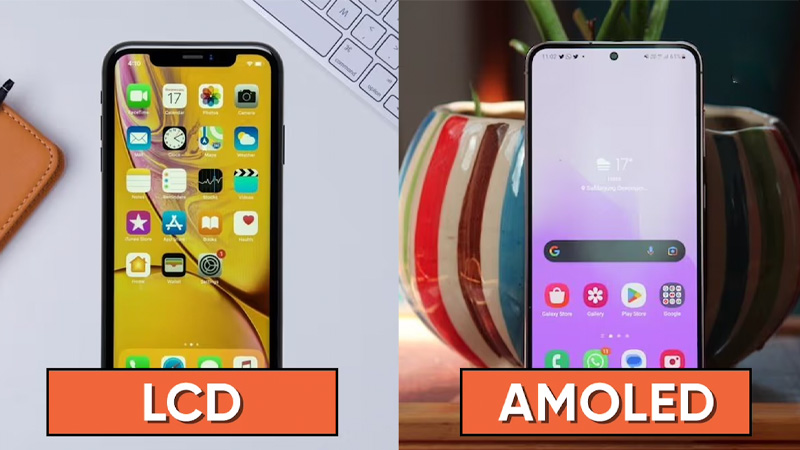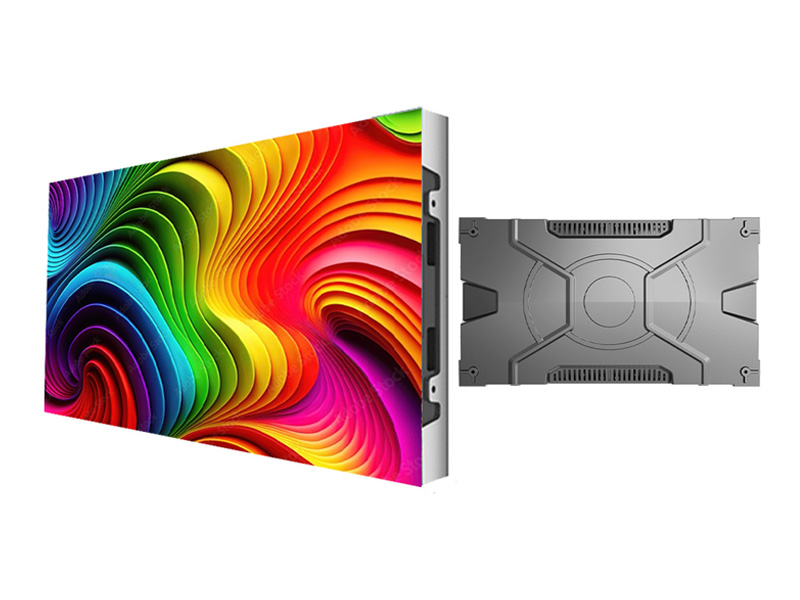AMOLED vs. LCD: Which One Suits You Best?
In a world where everyone has become screen-obsessed, our devices are practically extensions of ourselves. From catching up on social media feeds and streaming the latest movies to losing ourselves in epic gaming sessions, the quality of our screens can make a world of difference. But with so many options out there, how do you choose the display technology that’s right for you?
Let’s look closely at two popular display technologies today: AMOLED and LCD. We will discuss the details and see how each one meets a different purpose. Don’t forget to decide what suits you best at the end of this article.
Active-Matrix Organic Light Emitting Diode is known as AMOLED. These displays use different methods to produce light and display images. Each pixel is made of organic materials that glow when an electric current passes through them. LCD screens use a backlight to display images, whereas these screens generate their own light for the display. This means AMOLED screens can show brighter colors and deeper blacks.
-
How the Screen Creates Its Own Light:
AMOLED displays have a self-emissive nature that allows each pixel to be separately turned on or off. A pixel can be completely turned off when it is not in use. This leads to true blacks and an infinite contrast ratio. It is useful if you like watching movies or playing games in which dark scenes keep appearing.
-
Thin and Flexible Design:
Since AMOLED displays do not need a backlight, they are thinner and more flexible than LCDs. Curved screens and foldable devices can be developed because of this flexibility. It improves the design and the usefulness of modern gadgets.
-
Color Precision and Saturation:
AMOLED screens have vibrantly saturated colors. They cover a wider range of colors that make images look more appealing. But this saturation sometimes leads to oversaturated colors. Not all people like this, particularly those who prefer more natural tones.
LCD stands for Liquid Crystal Display. It has been a part of screens for a long time.
LCDs are different from AMOLED because they use a backlight to light up the pixels. These pixels are made up of liquid crystals. However, the crystals do not produce light on their own because they control how the light from the backlight passes through to form images.
-
Backlight Dependence:
LCDs can’t emit the same level of contrast as AMOLED screens because they need a backlight to work. Blacks on an LCD are not truly black but rather dark gray. Some light always must leak through the liquid crystals. However, technological advancements like IPS (In-Plane Switching) LCDs have improved color reproduction.
-
Brightness and Outdoor Visibility:
LCDs perform better than AMOLEDs when it comes to brightness. Higher brightness levels make them suitable for outdoor use in bright sunlight. You can easily increase the backlight on LCD screens to make them visible in bright conditions. But AMOLED screens still struggle to stay visible in very bright environments.
-
Color Accuracy:
AMOLED screens have brighter colors, but LCD screens reproduce more accurate colors. High-quality LCD panels with IPS technology display colors more naturally. People prefer LCDs for tasks like photo editing and graphic design.
When choosing between AMOLED and LCD displays, it’s essential to understand the key differences and how they align with your needs. Here’s a breakdown:
-
Power Consumption
Make sure you think about your battery health when picking between AMOLED and LCD.
● AMOLED Power Efficiency: AMOLED displays have a big advantage of turning off individual pixels when they are not in use. This feature helps in showing deeper blacks and reduces power use when the screen displays dark images. But AMOLED screens might use more power than LCDs if they display colorful images or white backgrounds.
● LCD Power Consumption: LCDs use the same amount of power no matter what is on the screen. Leaving the backlight on all the time can use more power on LCD screens when showing dark images as compared to AMOLED screens. But LCDs use less power for activities where the screen mainly displays white. Examples of such activities are web browsing or document editing.
-
Concerns About Longevity and Burn-In
Display longevity and burn-in are important issues to consider when making a choice between AMOLED and LCD.
● AMOLED Burn-In: Burn-in is always a risk in AMOLED displays. They occur when static images are displayed for longer periods. This leads to permanent ghosting on the screen. Modern AMOLED displays have tried to fix this problem. However, it remains an issue for users who keep displaying static content.
● LCD Longevity: LCD screens do not suffer from burn-in like AMOLED screens. This is because the technology has been around longer. Manufacturers have even optimized it for durability. While the backlight in an LCD screen can get dimmer over time, this usually happens slowly and is not as noticeable as an AMOLED burn-in.
-
Cost Considerations
Cost is important to consider for many consumers when they choose between displays.
● AMOLED Pricing: AMOLED screens are more expensive than LCDs. The complex manufacturing process and the use of organic materials raise expenses. This is why devices with AMOLED displays have a higher price, even in mid-range and budget categories.
● LCD Affordability: LCD technology has been used for a long time and is cheaper. The production process is well-developed, and making more of the product has lowered costs. LCDs are a popular choice for budget and mid-range devices because they are more affordable.
-
Use Cases and Preferences
Deciding between AMOLED and LCD mostly comes down to what you need and prefer. Let’s find some scenarios where one might be more suitable than the other.
● Entertainment and Gaming: AMOLED is the better choice if you love movies or gaming and want vibrant colors for an engaging experience. You will prefer choosing AMOLED screens because they have pixels that light up on their own.
● Professional Work: Getting colors right is really important for people working in photography, video editing, or graphic design. An IPS LCD display offers accurate colors and could be a better choice for these tasks.
● Outdoor Use: An LCD display is better to use if you are outside in bright sunlight. The backlight makes sure the screen is easy to see in varying lighting conditions.
● Budget Considerations: An LCD display gives you great value for the price if you are on a tight budget. Even though an LCD screen might not have the deep blacks and bright colors of an AMOLED screen, it can still offer you an enjoyable experience.
-
Future Trends and Innovations
The competition between AMOLED and LCD technologies keeps pushing both fields to improve. This has now led to exciting new advancements.
● AMOLED Advancements: AMOLED technology is growing as we speak. Manufacturers are working on reducing burn-in risks, along with improving brightness and enhancing color accuracy. Micro-LED technology (which is like OLED in some ways) could potentially take display technology to new heights.
● LCD Innovations: Nothing is stopping LCD technology from improving. I can give you an example. Quantum Dot LCDs are comparable to AMOLED displays now because they offer better color and brightness. Mini-LED backlighting also boosted LCD displays by making their contrast and black levels much better. They are now almost as good as OLED screens.
Expect a wide variety of LED display solutions at LEDSINO. We offer clear and versatile visuals that lead the way in visual technology. Our products cater to different needs that range from high-impact advertising to dynamic event displays. You don’t have to worry about being in control rooms or even in corporate settings. The advanced LED technology used in our displays exposes vibrant colors with enhanced brightness. They are energy efficient and ideal for both indoors and outdoors.
Digital visual demands continue to grow, don’t they? Our cutting-edge solutions will provide you with the flexibility and innovation necessary to stay ahead in the market. Your customers will be engaged, and you will be delivered with important real-time information. Our LED displays are made to guarantee you the highest standards of performance and reliability. You can ensure your visual communications always stay impactful and effective by choosing LEDSINO. Avail up to 3 years of warranty for the products you choose. So, why wait more?
![]() Front-end Convenient Maintenance
Front-end Convenient Maintenance
![]() Cabinet Size: 600*337.5mm/16:9 Ratio
Cabinet Size: 600*337.5mm/16:9 Ratio
![]() Compatible with 300*168.75mm Module
Compatible with 300*168.75mm Module
![]() With 3 Years Warranty and 5% Spare Parts
With 3 Years Warranty and 5% Spare Parts
![]() Front Convenient Maintenance
Front Convenient Maintenance
![]() Hard Connection, No Need Cables
Hard Connection, No Need Cables
![]() Can Removable Back Power Supply Box
Can Removable Back Power Supply Box
![]() With 3 Years Warranty and 5% Spare Parts
With 3 Years Warranty and 5% Spare Parts
5. Final Verdict
People still argue if AMOLED is the better option in comparison to LCD. But what is the final verdict? Or is it a tie? Remember that your choice should depend on what is most important for you. AMOLED is better if you like deep blacks, vibrant colors, and cutting-edge design. But you will like an LCD screen if you care about getting a bright display and saving money.
The decision is based on personal preference and use case because both have their strengths and weaknesses. AMOLED and LCD screens are looking more alike as technology starts to improve. But each of them has factors that meet different needs.
Think about how you use your device and what you want most from your display. Consider how much you are willing to spend before making your decision. By learning about the differences between them, you can pick the one that will make your digital experience better.
Contact
 Building D, Hongfa Science Park,
Building D, Hongfa Science Park,
2035 Songbai Road, Shiyan, Bao’an District, Shenzhen, Guangdong, China.

